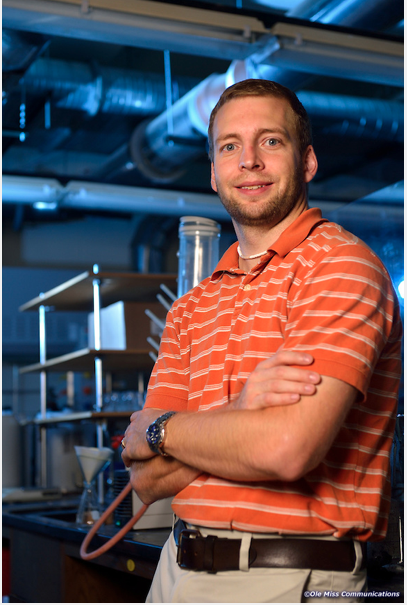
Jared Delcamp, Associate Professor of Chemistry and Biochemistry
Associate Professor of Chemistry & Biochemistry
delcamp@olemiss.edu
GROUP WEBPAGE
EDUCATIONAL AND PROFESSIONAL BACKGROUND
B.S., University of Kentucky-Lexington, 2005
Ph.D. University of Illinois-Urbana-Champaign, 2010
Postdoctoral Researcher, Swiss Federal Institute of Technology, 2010-2012
Postdoctoral Researcher, Georgia Institute of Technology, 2012-2013
Assistant Professor, University of Mississippi, 2013-2019
Associate Professor, University of Mississippi, 2019-present
PROFESSIONAL RECOGNITION
National Science Foundation Faculty Early Career Development (CAREER) Award
RESEARCH INTERESTS
Organic Chemistry, Energy Production, Solar Cells, Photocatalysis, Solar Fuel Production, Physical Organic Chemistry, CO2 Reduction
RESEARCH SUMMARY
The Delcamp laboratory is interested in the converting solar energy into more readily usable energy forms. We have two main focuses for accomplishing this goal: 1) generation of electrical energy and 2) generation of chemical energy.
In order to generate electrical energy from sunlight, we are further developing organic small molecules for the already promising dye-sensitized solar cell (DSC). We aim to broaden the strategies used in designing organic light harvesting materials for DSCs and organic photovoltaics. We are currently developing novel organic building blocks which will be amendable to a diverse array of organic electronic applications. Several of the polycyclic building blocks of interest are designed to balance competing local and larger annulenic aromaticities which should lead to unique light absorption characteristics from small molecules.
Additionally, we are interested in the generation of carbon based fuels from readily abundant CO2 with sunlight as the energy source. In order to photocatalytically convert a highly oxidized carbon source (CO2) into a more readily usable form, we aim to design catalytic systems capable of facilitating multiple synergistic chemical processes. Our focuses are on developing systems with no stoichiometric bi-products as is desirable for an energy projection technology and in further increasing the light absorption and catalytic activity of CO2 converting organometallic complexes.
RECENT PUBLICATIONS
23) Brogdon, P.; Cheema, H.; Delcamp, J. H. “NIR Absorbing Metal-Free Organic, Porphyrin, and Phthalocyanine Dyes for Panchromatic DSCs” ChemSusChem 2017, DOI: 10.1002/cssc.201701441. CA [link]
22) Boudreaux, C. M.; Liyanage, N. P.; Shirley, H.; Siek, S.; Gerlach, D. L.; Qu, F.; Delcamp, J. H.; Papish, E. T. “Ruthenium(II) complexes of pyridinol and N-heterocyclic carbene derived pincers as robust photocatalysts for selective carbon dioxide reduction” Chem. Commun. 2017, DOI:10.1039/C7CC05706G. T2H [link]
21) Cheema, H.; Peddapuram, A.; Adams, R. E.; McNamara, L.; Hunt, L. A.; Le, N.; Watkins, D. L.; Hammer, N. I.; Schmehl, R. H.; Delcamp, J. H. “Molecular Engineering of NIR Absorbing Thienopyrazine Double Donor Double Acceptor Organic Dyes for DSCs” J. Org. Chem. 2017, DOI: 10.1021/acs.joc.7b01750. CA/T2H [link]
20) Brogdon, P.; Cheema, H.; Delcamp, J. H. “Low-Recombination Thieno[3,4-b]thiophene-based Photosensitzers for DSCs” ChemSusChem 2017, 10, 3624. CA [link]
19) Cheema, H.; Rodrigues, R. R.; Delcamp, J. H. “Sequential Series Multijunction Dye-Sensitized Solar Cells (SSM-DSCs): 4.7 Volts from a Single Illuminated Area” Energy Environ. Sci. 2017, 10, 1764. T2H [link]
18) McNamara, L. E.; Rill, T. A.; Huckaba, A. J.; Ganeshraj, V.; Gayton, J.; Nelson, R. A.; Sharpe, E. A.; Dass, A.; Hammer, N. I.; Delcamp, J. H. “Indolizine-Squaraines: NIR Fluorescent Materials with Molecular Engineered Stokes Shifts” Chem. Eur. J. 2017, 23, 12494. T2H/HC [link]
17) Liyanage, N. P.; Cheema, H.; Baumann, A.; Zylstra, A. R.; Delcamp, J. H. “Effect of Donor Strength and Bulk on Thieno[3,4-b]pyrazine based Panchromatic Dyes in DSCs” ChemSusChem, 2017, 10, 2635. CA/REU2 [link]
16) Zhang, Y.; Autry, S. A.; McNamara, L. E.; Nguyen, S. T.; Le, N.; Brogdon, P.; Watkins, D. L.; Hammer, N. I.; Delcamp, J. H. “Near-infrared Fluorescent Thienothiadiazole Dyes with Large Stokes Shifts and High Photostability” J. Org. Chem. 2017, 82, 5597. T2H [link]
15) Peddapuram, A.; Cheema, H.; Adams, R. E.; Schmehl, R. H.; Delcamp, J. H. “A Stable Panchromatic Green Dual Acceptor, Dual Donor Organic Dye for Dye-Sensitized Solar Cells” J. Phys. Chem. C. 2017, 121, 8770. T2H/CA [link]
14) Cope, J. D.; Liyanage, N. P.; Kelley, P. J.; Denny, J. A.; Valente, E. J.; Webster, C. E.; Delcamp, J. H.; Hollis, T. K. “Electrocatalytic Reduction of CO2 with CCC-NHC Pincer Nickel Complexes” Chem. Commun. 2017, 53, 9442. T2H [link]
13) Cheema, H.; Delcamp, J. H. “Harnessing Photovoltage: Effects of Film Thickness TiO2 Nanoparticle Size, MgO and Surface Capping with DSCs” ACS Appl. Mater. Interfaces 2017, 9, 3050. T2H [link]
12) Huckaba, A. J.; Yella, A.; McNamara, L. E.; Steen, A. E.; Murphy, J. S.; Carpenter, C. A.; Puneky, G. D.; Hammer, N. I.; Nazeeruddin, M. K.; Grätzel, M.; Delcamp, J. H. “Molecular Design Principles of Near-Infrared Absorbing and Emitting Indolizine Dyes” Chem. Eur. J. 2016, 22, 15536. CA/T2H/HC/REU [link]
11) Liyanage, N. P.; Dulaney, H. A.; Huckaba, A. J.; Jurss, J. W.; Delcamp, J. H. “Electrocatalytic Reduction of CO2 to CO With Re-Pyridyl-NHCs: Proton Source Influence on Rates and Product Selectivities” Inorg. Chem. 2016, 55, 6085. T2H [link]
10) Huckaba, A. J.; Yella, A.; Brogdon, P.; Murphy, J. S.; Nazeeruddin, Md. K.; Grätzel, M.; Delcamp, J. H. “A Low Recombination Rate Indolizine Sensitizer for Dye Sensitized Solar Cells” Chem. Commun. 2016, 52, 8424. CA/HC [link]
9) Liyanage, N.; Yella, A.; Nazerruddin, Md. K.; Grätzel, M.; Delcamp, J. H. “Desymmetrization of Thieno[3,4-b]pyrazine via C-H Activation and Applicaiton as an Electron Deficient π-Bridge in D-A-π-A DSCs” ACS Appl. Mater. Interfaces 2016, 8, 5376. CA [link]
8) Brogdon, P.; McNamara, L. E.; Peddapuram, A.; Hammer, N. I.; Delcamp, J. H. “Toward Tightly Bound Carboxylic Acid-Based Organic Dyes for DSCs: Relative TiO2 Binding Strengths of Benzoic Acid, Cyanoacrylic Acid, and Conjugated Double Carboxylic Acid Anchoring Dyes” Synth. Met. 2016, 222, 66. T2H/T1 [link]
7) Huckaba, A. J.; Sharpe, E. A.; Delcamp, J. H. “Photocatalytic Reduction of CO2 with Re-Pyridyl-NHCs” Inorg. Chem. 2016, 55, 682. T2H/HC [link]
6) McNamara, L. E.; Liyanage, N.; Peddapuram, A.; Murphy, J. S.; Delcamp, J. H.; Hammer, N. I. “Donor-Acceptor-Donor Thienopyrazines via Pd-Catalyzed C-H Activation as NIR Fluorescent Materials” J. Org. Chem. 2016, 81, 32. T1/T2H/HC [link]
5) Brogdon, P.; Giordano, F.; Puneky, G. A.; Dass, A.; Zakeeruddin, S. M.; Zazeeruddin, Md. K.; Grätzel, M.; Tschumper, G.; Delcamp, J. H. “A Computational and Experimental Study of Thieno[3,4-b]thiophene as a Proaromatic π-Bridge in DSCs” Chem. Eur. J. 2016, 22, 694. T1/CA/HC [link]
4) Hammer, N. I.; Sutton, S.; Delcamp, J. H.; Graham, J. D. “Photocatalytic Water Splitting and Carbon Dioxide Reduction” Handbook of Climate Change Mitigation and Adaptation 2015, Springer, DOI: 10.1007/978-1-4614-6431-0_46-2. SU
3) Huckaba, A. J.; Giordano, F.; McNamara, L. E.; Dreux, K. M.; Hammer, N. I.; Tschumper, G. S.; Zakeeruddin, S. M.; Grätzel, M.; Nazeeruddin, Md. K.; Delcamp, J. H. “Indolizine-Based Donors as Organic Sensitizer Components for Dye-Sensitized Solar Cells” Adv. Energy Mater. 2015, 5, 1401629. T1 [link]
2) Nimmala, P. Knoppe, S.; Jupally, V.; Delcamp, J.; Aikens, C.; Dass, A. “Au36(SPh)24 Nanomolecules: X-ray Crystal Structure, Optical Spectroscopy, Electrochemistry and Theoretical Analysis” J. Phys. Chem. B 2014, 118, 14157. SU [link]
1) Jupally, V. R.; Dharmaratne, A. C.; Crasto, D.; Huckaba, A. J.; Kumara, C.; Nimmala, P. R.; Kothalawala, N.; Delcamp, J. H.; Dass, A. “Au137(SR)56 nanomolecules: composition, optical spectroscopy, electrochemistry and electrocatalytic reduction of CO2” Chem. Commun. 2014, 50, 9895. T1 [link]




 orcid.org/0000-0001-6942-5451
orcid.org/0000-0001-6942-5451

